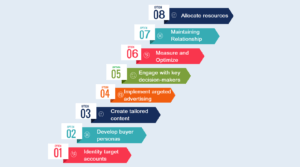Introduction to Account-based Marketing
Account-Based Marketing (ABM) is a strategic approach to B2B marketing that focuses on targeting specific accounts rather than a broad range of prospects. By focusing on a select group of accounts, ABM allows businesses to create highly personalized and targeted marketing campaigns that are more likely to generate leads and close deals.
As for the future of Account-based marketing, it is expected to keep growing and evolving as more B2B companies realize the benefits and effectiveness of the ABM approach. With the increasing amount of data and technology available, companies can create even more personalized and effective ABM campaigns and improve their measurement and analysis of the results. Additionally, more companies will adopt an ABM approach, and it will become more mainstream.
Key steps for Account-Based Marketing Strategy:
Creating a strategy for account-based marketing (ABM) project involves several key steps:
- Identity target accounts: This step is crucial as it sets the foundation for the rest of your ABM strategy. By identifying your target accounts, you can create a targeted and effective ABM campaign that is more likely to generate leads and close deals. Identify the specific accounts you want to target based on company size, industry, location, or other criteria.
- Develop buyer personas: Buyer personas are fictional representations of your ideal customers. Once you have identified your target accounts, it’s important to develop buyer personas for each of them to understand their specific needs, pain points, and decision-making processes. This will help you create content and campaigns that address their specific needs.
- Create tailored content: To effectively engage your target accounts, you need to provide them with valuable content that addresses their specific needs. This could include whitepapers, case studies, webinars, and other content types that will be valuable to them. This will help you generate leads and build trust with your target accounts.
- Implement targeted advertising: Use targeted advertising to reach your target accounts and drive them to your tailored content. This could include paid search, social media advertising, and display advertising. Using targeted advertising, you can reach your target accounts more precisely and generate more qualified leads.
- Engage with key decision-makers: Identify the key decision-makers within your target accounts and engage with them directly. This could include targeted email campaigns, direct mail, or face-to-face meetings. By engaging with key decision-makers, you will be able to build relationships and understand their specific needs, which will make it more likely that you will close deals.
- Measure and Optimize: Measuring and optimizing your ABM efforts is crucial to success. Use analytics and data to track the performance of your campaigns and make data-driven decisions. Measure the results of your ABM efforts and optimize your strategy based on what works and is not. This will help you fine-tune your strategy and improve your ROI.
- Maintaining Relationship: Building and maintaining relationships with your target accounts is key to success in ABM. Keep in touch with them and continue to provide them with valuable content and resources. This will help you build trust and credibility with your target accounts and increase the likelihood of closing deals and generating repeat business.
- Allocate resources: It is important to allocate the necessary resources, such as budget, technology, and personnel, to execute a successful ABM strategy. This may include hiring a dedicated ABM team, investing in ABM software, or allocating a specific budget for ABM activities. You will be better equipped to execute your ABM strategy and achieve your goals by allocating the necessary resources.
Example of Account-Based Marketing Strategy:
ABM aims to create highly personalized and targeted marketing campaigns that are more likely to generate leads and close deals.
For example, a software company wants to target large enterprise companies in the financial services industry. They would first identify their target accounts by researching companies that fit those criteria. Next, they would develop buyer personas for decision-makers within those companies to understand their specific needs, pain points, and decision-making processes.
Next, they would create tailored content such as whitepapers, case studies, and webinars that address the specific needs of the decision-makers in their target accounts. They would also implement targeted advertising to reach these accounts, such as paid search and display advertising on financial services industry websites.
The software company would also directly engage with key decision-makers within their target accounts through targeted email campaigns and face-to-face meetings. They would use analytics and data to track the performance of their campaigns and make data-driven decisions. They would measure the results of their ABM efforts and optimize their strategy based on what is working and what is not.
Finally, they would maintain relationships with their target accounts by keeping in touch and providing valuable content and resources. By following this ABM process, the software company would be more likely to generate leads and close deals with large enterprise companies in the financial services industry.









